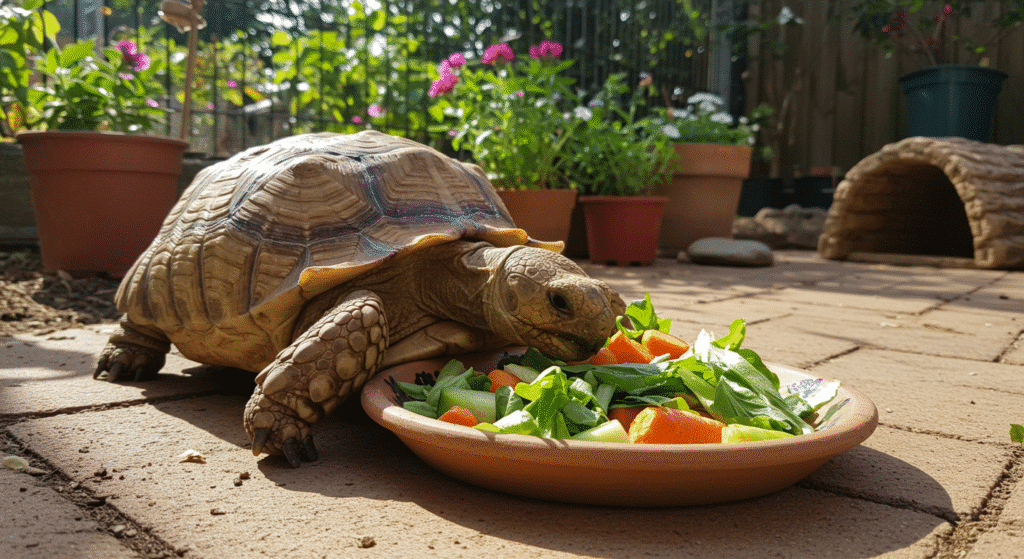Most tortoises are clad in colours that either help them avoid detection by predators or thermoregulate more effectively.
For example, leopard tortoises (Stigmochelys pardalis) have very intricate markings, which make it easy for the animals to blend in with the dappled light and grass that are common in their natural range. Meanwhile, adult Galapagos tortoises (Chelonoidis niger) don’t have natural predators aside from humans, so they are generally quite dark in color, which helps them raise their body temperature when necessary.
But every so often, a tortoise develops a genetic mutation that causes them to display unusual colors. In some cases, these mutations prevent the tortoise from producing normal quantities of melanin – a dark-colored pigment that’s present in most tortoise species.
And while these tortoises aren’t well-suited for life in the wild, they may thrive in captivity, where they’re protected from predators and provided with nearly ideal environmental conditions. Additionally, many keepers find these unusually colored animals to be incredibly attractive.
Allow me to share some of the facts about albino tortoises below so you can decide if you want to work with one of these beautiful animals.
What Is an Albino Tortoise?
The term “albino” is used in different ways by different groups of people. In humans, the term refers to people who cannot produce melanin, resulting in pale skin, light-colored hair, and pink or red eyes. Many people with albinism have poor eyesight as a side-effect of the condition.
Most tortoises labelled as albino look somewhat similar. But because tortoises can also produce red and yellow pigments, they don’t look exactly like albino humans. For example, the areas on the tortoise that are normally red or yellow often look relatively normal or even brighter than normal. Meanwhile, the dark areas of the tortoise will appear very light – often white – in color.
However, there are a number of genetic mutations that can affect the pigments an animal produces, and some are also attached to the term albino.
For example, some animals still produce a chemical called tyrosinase, which tends to make them display richer gold and purple colours than albinos who do not produce tyrosinase. The former are often called T+ (tyrosinase positive) albinos, while the latter are called T- (tyrosinase negative) albinos.
Additionally, some reptiles appear all white except for their eyes, which are black or blue. These animals are often called leucistic. And finally, some animals still produce some melanin, but they do not produce as much as they normally would. These animals are often called hypomelanistic (“hypo” means less or fewer).
How Are Albino Tortoises Created?
As explained at the outset, albinism (in its many forms) is caused by any of several gene mutations. Most mutations like this are thought to happen randomly. But once they’ve occurred, many are found to be heritable, meaning that they can be passed on to the animal’s offspring.
This can occur in several, often predictable, ways. But to understand how this works, you must first understand a little about genes.
Many physical traits are controlled by two copies of the same gene. One is inherited from the animal’s mother, and the other is inherited from the animal’s father.
Typically, both copies of the gene are identical. But when a mutation occurs, the animal ends up with two different versions of the gene (these different versions of the same gene are called alleles). Usually, only one of these genes is “expressed,” meaning that it causes a change to the animal’s biology or appearance.
Some gene mutations are said to be dominant. When a dominant gene is present, it is always expressed, regardless of what the other gene is. Other genes are said to be recessive. They are not expressed when paired with a normal version of the gene. They only cause changes to the animal’s biology or appearance when the animal has two copies of the mutated gene.
Most forms of albinism are recessive.
So, let’s walk through an example of how this would work in the real world:
- A random genetic mutation occurs in a tortoise species. However, because it will likely only have one copy of the mutated (albino) gene, the animal will appear normal.
- Later, this animal breeds with another member of its species that has two copies of the normal gene.
- Statistically speaking, half of the resulting offspring will have one copy of the mutated gene. However, they will all look normal.
- Later, one of these offspring will breed with the parent that possessed the original mutated gene.
- Statistically speaking, one quarter of the resulting offspring will have only normal genes, one half of the offspring will receive one copy of each gene version, and one quarter of the animals will receive two copies of the mutated gene. This means that three quarters of these animals will look normal, while the quarter who received two copies of the mutated gene will appear albino.
To help provide more efficient communication, animals with two copies of the same gene are said to by homozygous; animals with two different versions of the gene are said to by heterozygous.
Do Albino Tortoises Have Health Problems?
Many albino animals suffer from health problems caused by their lack of pigment.
Most appear to be more susceptible to skin damage than normally pigmented animals, as they don’t enjoy the protective benefits melanin provides. Some albino animals also have poor vision, while some even have hearing problems.
But we don’t fully understand whether or not albino tortoises suffer from these problems. As time goes on and keepers have the chance to work with more albino tortoises, we may learn more about this issue. However, most albino tortoises do seem to live full, problem-free lives.
What Tortoise Species Are Available in Albino Form?
Albinism hasn’t been documented in every tortoise species. In fact, it is completely unreported for most. However, at least one form of albinism has been reported in the following species:
- Galapagos tortoise (Chelonoidis niger)
- Red-footed tortoise (Chelonoidis carbonarius)
- Pancake tortoise (Malacochersus tornieri)
- Sulcata (Centrochelys sulcata)
- Hermann’s tortoise (Testudo hermanni)
- Greek tortoise (Testudo graeca)
Additionally, there are scattered reports of albino leopard tortoises (Stigmochelys pardalis), though they don’t yet appear to be confirmed.
Citations
- LiveScience — Tiny white tortoise baby is the ‘first of its kind’
- Reptiles Magazine – Albino Sulcata Tortoise
- Arizona Tortoise Compound – Albinism in Tortoises

